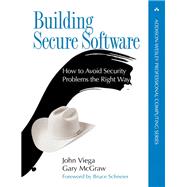
Note: Supplemental materials are not guaranteed with Rental or Used book purchases.
Purchase Benefits
Looking to rent a book? Rent Building Secure Software How to Avoid Security Problems the Right Way (paperback) [ISBN: 9780321774958] for the semester, quarter, and short term or search our site for other textbooks by Viega, John; McGraw, Gary. Renting a textbook can save you up to 90% from the cost of buying.
John Viega is the CTO of Secure Software Solutions (www.securesw.com) and a noted expert in the area of software security. He is responsible for numerous tools in this area, including code scanners (ITS4 and RATS), random number suites (EGADS), automated repair tools, and secure programming libraries. He is also the original author of Mailman, the GNU mailing list manager.
Gary McGraw, Cigital's CTO, is a leading authority on software security. Dr. McGraw is coauthor of the groundbreaking books Building Secure Software and Exploiting Software (both from Addison-Wesley). While consulting for major software producers and consumers, he has published over ninety peer-reviewed technical publications, and functions as principal investigator on grants from DARPA, the National Science Foundation, and NIST's Advanced Technology Program. He serves on the advisory boards of Authentica, Counterpane, and Fortify Software. He is also an advisor to the computer science departments at University of California, Davis, and the University of Virginia, as well as the School of Informatics at Indiana University.
The New copy of this book will include any supplemental materials advertised. Please check the title of the book to determine if it should include any access cards, study guides, lab manuals, CDs, etc.
The Used, Rental and eBook copies of this book are not guaranteed to include any supplemental materials. Typically, only the book itself is included. This is true even if the title states it includes any access cards, study guides, lab manuals, CDs, etc.